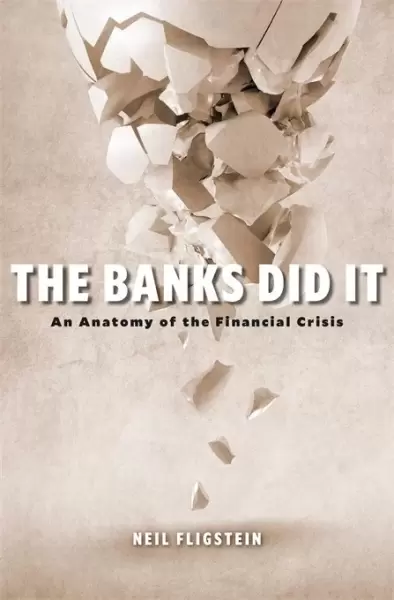
作者:NeilFligstein
出版社:HarvardUniversityPress
副标题:AnAnatomyoftheFinancialCrisis
出版年:2021-6-8
页数:336
定价:GBP31.95
装帧:Hardcover
ISBN:9780674249356
内容简介
······
A comprehensive account of the rise and fall of the mortgage-securitization industry, which explains the complex roots of the 2008 financial crisis.
More than a decade after the 2008 financial crisis plunged the world economy into recession, we still lack an adequate explanation for why it happened. Existing accounts identify a number of culprits—financial instruments, traders, regulators, capital flows—yet fail to grasp how the various puzzle pieces came together. The key, Neil Fligstein argues, is the convergence of major U.S. banks on an identical business model: extracting money from the securitization of mortgages. But how, and why, did this convergence come about?
The Banks Did It carefully takes the reader through the development of a banking industry dependent on mortgage securitization. Fligstein documents how banks, with help from the government, created the market for mortgage securities. The largest banks—Countrywide Financial, Bear Stearns, Citibank, and Washington Mutual—soon came to participate in every aspect of this market. Each firm originated mortgages, issued mortgage-backed securities, sold those securities, and, in many cases, acted as their own best customers by purchasing the same securities. Entirely reliant on the throughput of mortgages, these firms were unable to alter course even when it became clear that the market had turned on them in the mid-2000s.
With the structural features of the banking industry in view, the rest of the story falls into place. Fligstein explains how the crisis was produced, where it spread, why regulators missed the warning signs, and how banks’ dependence on mortgage securitization resulted in predatory lending and securities fraud. An illuminating account of the transformation of the American financial system, The Banks Did It offers important lessons for anyone with a stake in avoiding the next crisis.
作者简介
······
Neil Fligstein is Professor of Sociology at the University of California, Berkeley, and Director of the Center for Culture, Organization, and Politics at the Institute for Research on Labor and Employment. His previous books include The Transformation of Corporate Control, The Architecture of Markets, and Euroclash. He is a member of the American Academy of Arts and Sciences.
目录
······
List of Illustrations*
Preface
1. A Long, Strange Trip
2. From Mortgages to Mortgage Securitization
3. The Rise of the Vertically Integrated Private Banks, 1993–2001
4. Financial Innovation and the Alphabet Soup of Financial Products
5. The Subprime Moment, 2001–2008
6. The Crisis and Its Spread Worldwide
7. Fraud and the Financial Crisis
8. Why Did the Federal Reserve Miss the Financial Crisis of 2008?
9. The Banks Did It (With the Help of the Government!)
Notes
References
Acknowledgments
Index
* Illustrations
Figures
2.1. Homeownership rates for the United States, 1900–2008
2.2. Shares of nonfarm residential debt, 1895–2005
2.3. An announcement of the first MBS issued by Ginnie Mae in 1970
3.1. Residential mortgage origination by type, 1990–2003
3.2. Percentage of securitizations done by GSE, 1980–2001
3.3. Concentration in mortgage lending: top twenty-five market share
3.4. Percentage of all loans that were securitized
3.5. The vertically integrated bank, circa 2001
4.1. Asset-backed securities outstanding over time
4.2. Key institutions surrounding GSAMP Trust 2006-NC2
4.3. Capital structure of GSAMP Trust 2006-NC2
5.1. Residential mortgage origination by type, 1990–2008
5.2. Mortgage originations by purchase and refinance
5.3. Mortgage-related security holdings of four largest investor types, 2002–2008
5.4. Financial profits as a share of all profits
5.5. Amounts of MBS issuance by type for nonagency firms
5.6. Total of collateralized debt obligations and mortgage-related securities issuance, 2004–2008
5.7. Rise and fall of the ABCP market
6.1. Quarterly percentage change in national housing price index and share of subprime mortgages ninety-plus days delinquent or in foreclosure
6.2. Timeline of MBS credit downgrades
6.3. Average magnitude of subsequent Alt-A, B / C, and HEL downgrades by vintage
7.1. Credit-crisis-related settlements, 2007–July 2017
8.1. Ngram for house price bubble
8.2. Number of FOMC meetings where “house price bubble” was a topic, 2000–2009
9.1. Production of MBSs by private-label securities (non-GSE financial institutions) and the. total outstanding MBSs issued by the GSEs, 1999–2018
9.2. Agency and nonagency shares of residential MBS issuance, 1995–2018
9.3. Mortgage debt in the United States
9.4. Government holding of MBSs, 2002–2018
Tables
5.1. Dominant firms in selected mortgage finance segments, 1996 and 2007
6.1. What happened to the main players in the market
6.2. Countries that experienced a banking crisis, 2008–2009
6.3. Foreign countries with the highest amount of MBSs/GDP in 2006 and countries with the highest amount of ABCP/GDP
6.4. Largest banks with ABCP holdings with country of origin
7.1. Loan performance of nonconventional mortgages issued in 2002–2008
8.1. Voting members of the Federal Open Market Committee, 2000–2008
评论 ······
没有太多的创新,但难得写的清楚明白。Fed那一章有意思,这部分研究应也是和他的学生合作的。
新自由主义的支持者常说放手给市场,政府只创造条件,但没有明确到底是怎样的条件,甚至期待从第三世界国家SAP计划的人类学实验中找出头绪,critical thinkers试图说明这点,并且先从美国自己下手了,虽然还不好说这些主要源于历史分析的结论有多大普适性。在Fligstein这里,政府的形象是金融工具的innovator,本是设计出来应对危机、让系统更稳健以便政府从市场撤出的工具如证券化被华尔街…
围绕两条线索讲金融危机的产生:抵押贷款证券化、银行组织结构的垂直整合。七十年代经济滞胀,储蓄贷款银行模式崩溃,破产潮产生大量低价债券,MBS兴起。税法改革和CMO等衍生品的发明解决了MBS的提前还贷风险。八十年代形成了房贷发行、打包、批发、零售的完整产业链,投行和商业银行分别向上下游垂直整合,同时新自主主义放松银行管制。优质房贷资源耗尽之后出现各种金融创新,金融创新可以将风险标准化且获得政府信用背…
没有太多的创新,但难得写的清楚明白。Fed那一章有意思,这部分研究应也是和他的学生合作的。
评论前必须登录!
注册